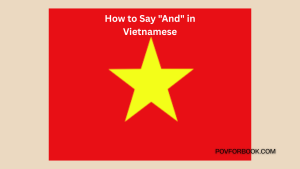Learning a new language can feel like stepping into an entirely different world. If you’ve ever traveled to Vietnam or tried to speak with a native speaker, you’ll realize quickly that even simple words carry a lot of cultural weight. One of the most essential and frequently used words in any language is “and.” It connects ideas, people, actions—essentially, it stitches your sentences together. In Vietnamese, the word for “and” is surprisingly simple yet used in fascinating ways.
But wait—don’t stop at just one word. In this article, you’ll not only learn how to say “and” in Vietnamese, but you’ll also uncover 20 other must-know Vietnamese words that will set the foundation for your language journey. Real-life examples, cultural notes, and simple explanations will keep you engaged, informed, and excited to learn more.
Let’s dive in!

1. How to Say “And” in Vietnamese
- The Vietnamese word for “and” is “và”.
Pronunciation:
- Pronounced as /vaa/ with a flat tone.
- Imagine saying “va” in “lava,” but shorter and clearer.
Examples:
- Tôi thích cà phê và trà. (I like coffee and tea.)
- Anh ấy chạy và nhảy. (He runs and jumps.)
Real-Life Example:
Ngoc, a university student in Hanoi, was helping a tourist find his way. She said, “Bạn đi thẳng và rẻ phải.” The tourist, confused at first, later smiled realizing “và” was the key to understanding direction.
Cultural Tip:
Vietnamese often drop conjunctions like “và” in casual speech. Instead of saying every single “and,” context is used to imply connection. But as a beginner, use “và” until you’re confident with nuances.
2. Top 5 Pronouns You Must Know
1. Tôi — I / Me
- Used in formal settings or when the relationship is undefined.
- Tôi là sinh viên. (I am a student.)
2. Bạn — You
- Used with equals or strangers around your age.
- Bạn khoẾbo không? (Are you okay?)
3. Anh / Chị / Em — You (based on age/gender)
- Anh: older male
- Chị: older female
- Em: younger person
These pronouns double as forms of address. For example:
Anh làm nghề gì? (What do you do, older brother?)
4. Chúng tôi — We (excluding the listener)
5. Chúng ta — We (including the listener)
Learning to use these correctly will earn you cultural points with locals!
3. Five Essential Verbs
6. Là — To be
- Đây là sách. (This is a book.)
7. Có — To have
- Tôi có hai người anh. (I have two brothers.)
8. Đi — To go
- Tôi đi chợ. (I go to the market.)
9. Ăn — To eat
- Tôi ăn phở. (I eat pho.)
10. Uống — To drink
- Bạn muốn uống trà không? (Do you want to drink tea?)
Real-Life Tip: Ordering food or drinks in Vietnam? These verbs are all you need.
4. Five Everyday Nouns
11. Nhà — House
- Tôi ở nhà. (I am at home.)
12. Trường — School
- Cô ấy đi trường. (She goes to school.)
13. Bánh mì — Bread/Sandwich
- Tôi muốn một cái bánh mì. (I want a sandwich.)
14. Tiền — Money
- Bạn có tiền lẻ không? (Do you have change?)
15. Nước — Water
- Cho tôi một chai nước. (Give me a bottle of water.)
Example: At a market, a vendor might say, “Bạn muốn bánh mì và nước không?” (Do you want bread and water?)
5. Five Everyday Adjectives
16. Đẹp — Beautiful
- Cô ấy rất đẹp. (She is very beautiful.)
17. Ngon — Delicious
- Món ăn này ngon quá! (This food is so delicious!)
18. Lớn — Big
- Nhà rất lớn. (The house is big.)
19. Nhỏ — Small
- Chiếc bàn nhỏ. (The table is small.)
20. Mệt — Tired
- Tôi mệt rồi. (I am tired.)
Real-Life Scenario: After a day exploring Hanoi, you might say to your friend, “Tôi mệt và muốn uống nước.” (I’m tired and want to drink water.)
6. Sentence Structure Simplified
Vietnamese follows the SVO (Subject-Verb-Object) structure:
- Tôi ăn phở. (I eat pho.)
- Bạn đi trường. (You go to school.)
- Use “và” to combine multiple objects or actions:
- Tôi uống trà và ăn bánh mì. (I drink tea and eat bread.)
7. Tips to Learn Vietnamese Faster
- Use Flashcards with tone markers.
- Talk with Locals on apps like HelloTalk.
- Watch Vietnamese Dramas with subtitles.
- Listen and Repeat instead of memorizing.
8. Common Mistakes Beginners Make
- Ignoring tones: “ma,” “má,” and “mà” are different words!
- Overusing “và” in informal speech.
- Using the wrong pronoun: Respect age and status.
- Translating directly from English.
Conclusion: Your First Step into Vietnamese
You’ve just learned how to say “and” in Vietnamese and picked up 20 of the most useful words to get started. Use them in everyday situations, practice pronunciation, and don’t be afraid to make mistakes. The more you engage, the faster you learn.
Whether you’re planning a trip, chatting with a Vietnamese friend, or diving into a new language just for fun—these words will serve as your foundation.
Keep practicing. Keep learning. Hoọc nói tiếng Việt thật vui! (Learning to speak Vietnamese is fun!)
Deven Kumar is the passionate writer and founder behind povforbook.com, a website dedicated to exploring unique perspectives in literature and storytelling. With a deep love for books, language and traveling, Deven aims to inspire readers by sharing insightful reviews, thought-provoking synopses, Guiding tourist by sharing personal experience and engaging content that highlights the power of narrative. When not writing, Deven enjoys connecting with fellow book lovers and traveling lovers and continuously discovering new voices in the literary world.
